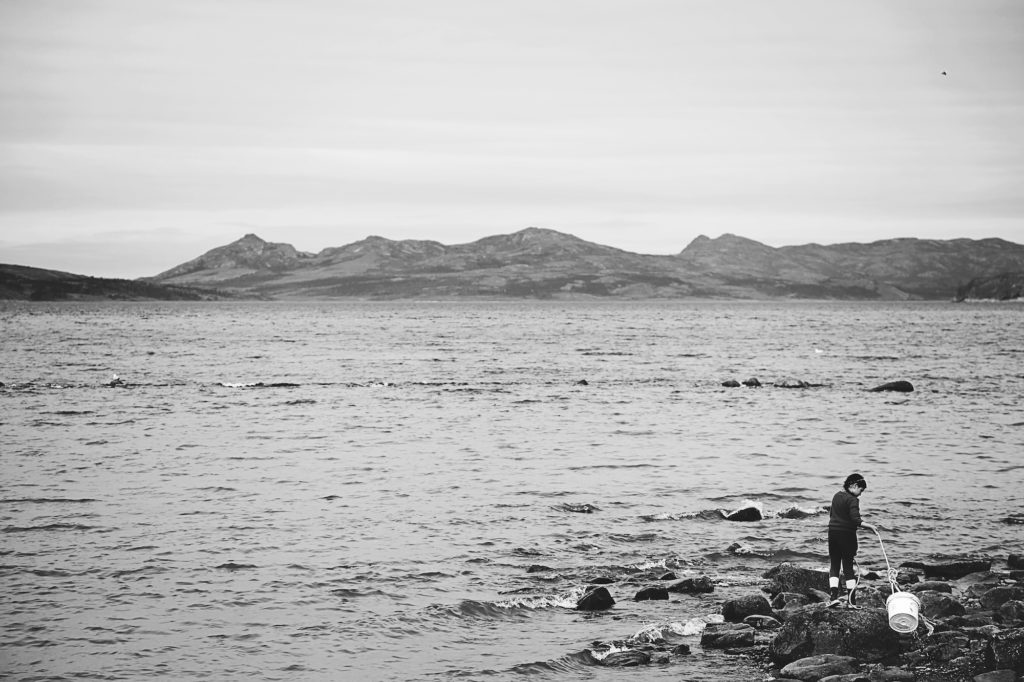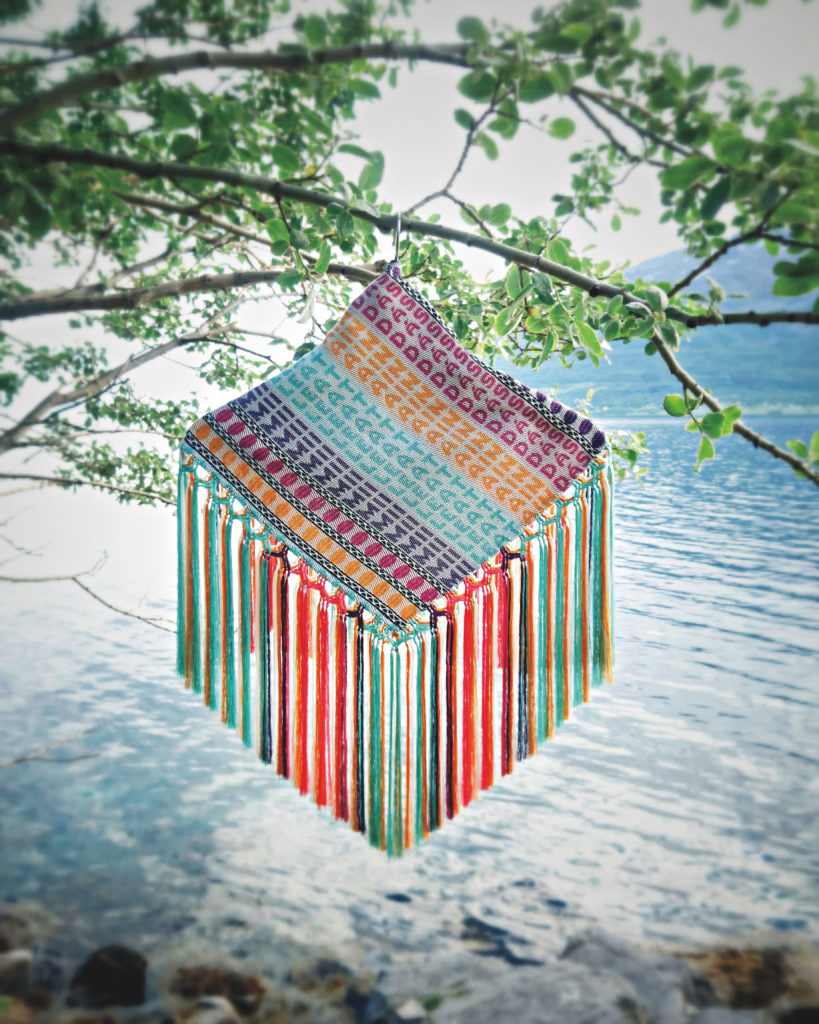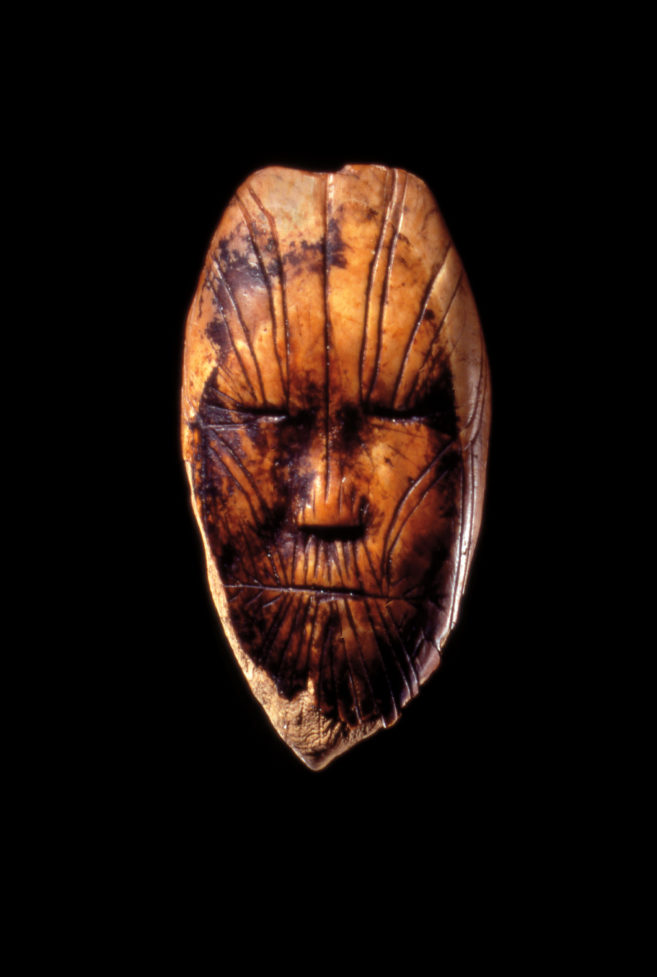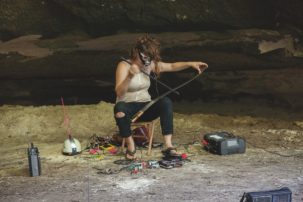Niillas Holmberg: When I was a child I got connected, so to speak, to the traditional way of Sámi singing that we call yoiking. It’s often said that you cannot really learn it if you didn’t hear it as a child. It’s always very evident. You can hear if someone didn’t start as a child, or if someone learned it as an adult. I heard it enough to learn when I was young. When I was a schoolchild, I was lucky enough to have Sámi cultural activists around me, who were doing their best to preserve our traditional ways. Yoik was taught a little bit in our school—we had workshops and I was hearing it here and there—but then I turned 11, 12, and I started listening to rap music and rock music and so on, and I wasn’t really thinking about traditional yoiking. I guess I didn’t really want to do it or I didn’t even consider it an option for years. It came back when I started making music on my own, playing guitar and singing. That was a road that took me back to yoiking. Now, during the last two or three years, I have come across an archive of traditional yoiks from my home region.
Just a short description of yoiks: we have personal yoiks for people, for animals, for places. When we yoik those yoiks, we’re not yoiking about that person. We are yoiking that person. So, it’s also said, and I think this is very essential, that the yoiker does not create a yoik, but merely channels it from their surroundings. That’s something that says a lot about our Indigenous worldview.
In recent years, I’ve come across those traditional person-yoiks from my region, and many are the yoiks of my ancestors—my family members who lived in the 19th century, for example. Very often yoiks have lyrics in them, but they’re not very wordy. They’re very poetic. Often they tell a lot about the person being yoiked. Learning these yoiks in the past three years, I’ve felt myself become much more rooted. One way to explain it is that some of those people lived such a long time ago that there are no more people who knew them personally. They were not famous people; there are no literary descriptions of them. These yoiks are the only way for me to know what my great-great-great-grandmother was like as a person. To know what she did and how she lived. It can be heard through the lyrics but also very much through the melody and the whole expression. And, by yoiking them, it’s very evident to me that I can feel the people I’m yoiking around me when I’m doing it.
Tiffany Ayalik: Like you’re conjuring them a bit?
NH: Yeah, something like that. One of the most famous yoikers, Wimme, actually told me last summer that he never yoiks human ancestors when he’s doing a concert abroad because he doesn’t want them to come there and stay there. He feels that it’s somehow risky. So he sticks with animal yoiks and stuff like that. So that’s a way of…
TA: Reading time?
NH: Yeah.
TA: Was yoiking ever banned by the different governments?
NH: Yes, they were very much not allowed. In the 1600s, you were condemned to death if you yoiked in some areas. It was considered a sin by the church. For example, my grandmother, who died last winter, never accepted yoiking. A lot of people from her generation were very affected by the church. I remember when I was growing up, there were yoiking concerts. When a person started yoiking, a lot of older people would stand up and walk away, because they were completely brainwashed by Christianity. The church was used as a political tool to get rid of all the elements that were seen as strange, and thus hard to control. So yoiking was banned. Different elements of our clothing were banned. Yoiking is very much connected to the mythical—
well, I guess you could say, the religious background of our people.
How the songs come about is just through being inspired by the natural world around us, by the sonic world. We’re listening to those things.
TA: It’s so similar with Inuit throat singing. All across Canada any sort of cultural practice was at one point punishable by fines or imprisonment, not just for Inuit but for anyone Indigenous.
Inuit throat singing is usually done by two people as a partner song. When we’re carrying our babies on our backs, it’s a way to soothe our babies to sleep. There’s also a game element to it—it’s really fun and since there are two singing, they can compete with each other. So there is this playful element. How [the songs] come about is just through being inspired by the natural world around us, by the sonic world. We’re listening to those things.
Throat singing, when the missionaries were around us, was very severely tabooed and shunned. I think this is a really common theme with missionaries: they see something they don’t understand and immediately it’s evil, satanic or sinful. Especially in terms of how the church suppresses women. Misogyny was also an element in the demonization of throat singing, because you have two women who are supporting each other and learning and bonding and spending time together, and standing very close. It’s a very intimate thing between two women. A beautiful bond like that is seen as sinful. We’re also making noises that, if you have no reference for them, can sound scary; it’s this sort of guttural, animalistic, deep, powerful thing. It’s no wonder the church was terrified.
There was a time, in the mid-1900s, when throat singing almost went extinct it was so taboo. Many people were afraid of practicing and many Elders who held traditional songs died and took that knowledge with them. That’s pretty devastating. But in some areas it did stay active, and there were still women who practiced it and eventually it started to come back. There are some very old wax-cylinder recordings of those songs and, thankfully, they survived and [throat singing] didn’t become another one of those practices that went away because of colonization. There’s been a real resurgence of throat singing and huge wins in that sense, where people are reclaiming the practice, taking it and making it their own. And doing really cool, fun, innovative things with it: mixing it with electronic music, country music, hip hop or beatboxing and just really owning it, so that we can also make it adaptable. Inuit are making it accessible in ways that we feel are exciting and relevant. I feel like that’s a sign of a strong culture, that it can remain grounded in tradition and things of the past but also allows for enough flexibility to adapt to changing times. And that new generations still find it relevant, and important, to keep incorporating traditional elements into their everyday lives. So it’s a really cool place, where throat singing is right now. There are really brave, awesome people who do this, despite what others may say from their couch at home, saying: “This isn’t traditional, this isn’t the Inuit way” and finger-wagging, you know.
NH: The throat-singing police.
TA: Yeah, throat singing policed by people who probably don’t throat sing anyways. There is a lot of that and I think that happens with anything as time goes on. It is probably the same with yoiking or other things about Sámi culture—there are the purists.
NH: Yeah. As the for the resurgence of traditional music in Sápmi, it really started flourishing again around 15 years ago and has really played such an important role in making our youth feel proud of their background again, to help them see that there is a future for their cultural heritage. It’s a very important thing when it comes to being healthy. Something that is important with yoiking is the cycle of it—I wonder if you share this? It’s very evident that the yoik goes around and around and around. That’s why it’s said that it doesn’t really start anywhere as a musical piece. It doesn’t end anywhere. It just exists and you can jump in wherever. I’ll give you an example. [yoiking] You can go on forever, forever, forever, and that is something that symbolizes the cyclical conception of time relevant to Sámi people, and I think to most Indigenous people in the world. We live by seasons. I think we understand that nature works in cycles. Everything is about cycles.
 Jennie Williams, Nain, Nunatsiavut, 2015. Digital photograph. Courtesy the artist.
Jennie Williams, Nain, Nunatsiavut, 2015. Digital photograph. Courtesy the artist.
TA: I feel that, especially for storytelling in the Western tradition, we’re obsessed with the set-up, the rising action, conflict, climax and then the resolve at the end. Everything follows a very Aristotelian way of looking at the arc of a story. This is sharply opposed to an Indigenous way of telling stories, where we don’t think of time as straight and linear—like past, present, future. Many things are happening simultaneously and I think that’s so cool, on a sort of quantum physics level. I always make this joke that when people say, “Well there’s no time like the present,” I always say, “There is, it’s just the past and the future—it’s exactly the same!”
NH: That’s also about basing one’s life on process instead of on goals. One could say that process is the only goal.
TA: The sensibility of time is very cyclical. It happens in cycles and seasons. Even things like life and death; it’s not really that you live and then you die. I think this idea that Spirit can still be very present in our lives really changes how we think about death or the finality of something. Instead of being the end, it’s just a continuation.
NH: It’s about them being timeless. It’s about the cycle of history repeating itself. I don’t think it necessarily repeats itself in a way of identical things happening again and again. They take new forms and this is what we
are seeing.
TA: Are there people who are taking yoiking and being very contemporary about it, and mixing it with all different kinds of musical styles?
NH: Very much so! It’s exactly as you said. Fifteen years ago it was rock and now it’s basically whatever musical genre is popular. That is what the Sámi youth are doing; they are making a fusion of yoik with the genres of music
they hear all the time.
TA: And are there also purists who are wagging their fingers and scolding
them about it?
NH: There are yoik police around. Fifty years ago, music pioneer Nils-Aslak Valkeapää (or Áillohaš as we call him) was the first one to bring yoik to the stage and to mix it with other music, Western music. He was very much condemned to hell and whatnot but he kept on doing it and then other people started following. Little by little it started growing and now it’s played on national radio in Norway, Sweden and Finland.
TA: With this rise in popularity and the taboo falling away, are there non-Sámi trying to adopt yoiking?
NH: Yeah, there’s always going to be something like that. There’s always something, no matter how positive things are. I don’t think there is a phenomenon which doesn’t have a single negative side effect to it. There’s always a counter phenomenon. And this has happened. There are television shows with celebrities trying to yoik, like top-notch Norwegian musicians and vocalists trying to yoik, and learning them.
TA: Same here too, especially when we travel to different cities or countries where people might not be as familiar with throat singing. People will come up to us after and say, “How do you do that? It’s so amazing. Can you teach
me?” Did you not just hear the history? This is something that we just got back. We just got this back. In the history of things, in the scheme of time, we just got the baby back, so let us hold it for a minute. This is something that non-Indigenous people shamed and shunned us for. All of a sudden now you love it. And now you want to use it for your own.
NH: We are expected to teach everyone…
TA: And share. When you go to a museum or an art gallery and you look at the beautiful things on the wall, you look at these beautiful pieces, you can see a piece of art, look at it and appreciate it. You can support the artist. You can look at the craft and the skill, but in order to fully appreciate it you don’t have to go and cut a little piece of the painting off and bring it home, as though that’s the only way you can appreciate it. We do it all the time. We let things be, we let things be on the wall and we appreciate them. To think that we have to then own a little part of it in order to fully appreciate it—it isn’t true. We recognize that with visual art and with a lot of cultural things, it’s the same: just appreciate the skill. Appreciate the history. Marvel at the artistry. Support the people who do it. You don’t have to be inside of it to fully appreciate it.
NH: You don’t have to own everything. You don’t.

 Anniina Turunen, Mii leat ain dás.
– We are still here, 2018. Silk yarn and viscose yarn, 90 x 90 cm.
Anniina Turunen, Mii leat ain dás.
– We are still here, 2018. Silk yarn and viscose yarn, 90 x 90 cm.






